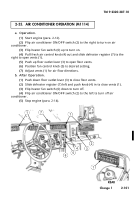TM-9-2320-387-10 - Page 154 of 277
TM 9-2320-387-10
2-106
b. Unusual Terrain Driving Techniques.
CAUTION
• Do not shift into any lower gear than is necessary to maintain head-
way. Attempt to maintain a constant engine speed. Over-revving
engine will cause the wheels to slip, and traction will be lost.
• Before ascending or descending steep hills, stop vehicle, place trans-
mission to N (neutral), and shift transfer case to L (low range). Failure
to shift transfer case to L (low range) before ascending or descending
steep hills may result in damage to drivetrain.
(1)
Before climbing a steep hill, shift the transfer case into L (low range) and
the automatic transmission into 1 (first). If wheels start to slip, walk the vehicle the
last few remaining feet of a hill by swinging the front wheels sharply left and right
if situation permits. This action will provide fresh “bite” into the surface and will
usually result in enough traction to complete the climb.
CAUTION
When L (low range) is used for engine braking while descending steep grades,
avoid sharp, continuous turns. Failure to avoid sharp, continuous turns while
operating transfer case in range may cause damage to drivetrain.
(2)
You can proceed safely down a steep grade by shifting the transfer case
into L (low range) and the transmission into 2 (second) or 1 (first). Let the vehicle go
slowly down the hill with all four wheels turning against engine compression.
.
WARNING
.
Do not travel diagonally across a hill unless it is absolutely necessary,
or injury to personnel or damage to equipment may result.
(3)
When moving across a slope, choose the least angle possible, keep moving,
and avoid turning quickly.
(4)
If it is difficult to shift out of a locked range, drivetrain torque buildup
may have occurred. If necessary to relieve drivetrain torque buildup when leaving a
low traction surface for a high traction surface, the vehicle should be backed up for
a distance of approximately 5 ft (1.5 m) before proceeding.
2-41. COLD WEATHER STARTING BELOW +32°F (0°C)
.
WARNING
.
Starting aids will not be used on the engine. Use of starting aids may
cause damage to vehicle and injury or death to personnel.
a.
Start engine (para. 2-12).
.
WARNING
.
• Do not use the hand throttle as an automatic speed or cruise control.
The hand throttle does not automatically disengage when brake is
applied, resulting in increased stopping distances and possible
hazardous and unsafe operation.
• Do not fully apply hand throttle when engine is not under load.
NOTE
If engine cranks slowly and voltmeter indicates low battery charge
level, attempt to slave start vehicle (para. 2-23). If vehicle still will not
start, perform troubleshooting procedures in table 3-1.
2-40. OPERATING ON UNUSUAL TERRAIN (Cont’d)
Back to Top




















